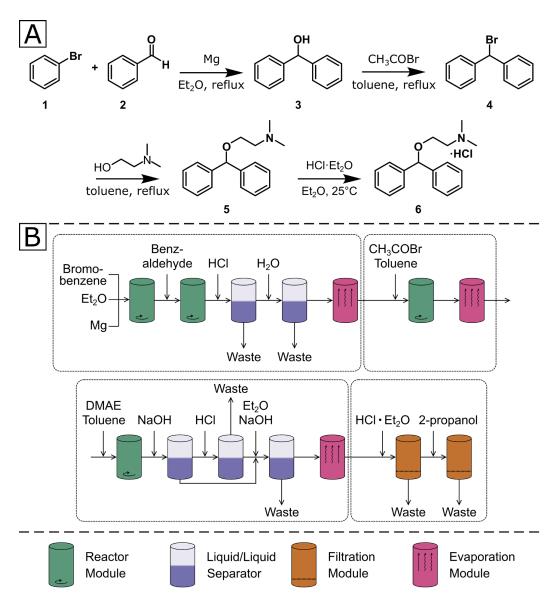ジフェンヒドラミン 塩酸塩 化学特性,用途語,生産方法
外観
白色, 結晶~結晶性粉末
定義
本品は、ジフェニルメトキシジメチルエタノールアミンの塩酸塩であり、次の化学式で表される。
溶解性
酢酸に極めて溶けやすく、水及びエタノールに溶けやすく、アセトンにやや溶けにくく、ジエチルエーテルにほとんど溶けない。水:1g/ml、エタノール:1g/2ml、アセトン:1g/50ml。氷酢酸, メタノールに極めて易溶。
用途
神経化学研究用。
用途
ジフェンヒドラミン誘導体で
す。抗ヒスタミン作用及びケミカルメディ
エーター遊離抑制作用を示します。
用途
抗アレルギー剤、抗ヒスタミン剤
化粧品の成分用途
ヘアコンディショニング剤、外用鎮痛剤、薬用収れん剤-皮膚防御剤
効能
抗アレルギー薬, H1受容体拮抗薬
商品名
ジフェンヒドラミン塩酸塩 (日新製薬-山形); レスタミン (興和)
説明
Diphenhydramine is most commonly used as a first-generation antihistamine and is globally marketed in various brand formulations (Benadryl®, Unisom®, Tylenol®, Zzzquil®). It competitively blocks H1 receptors, thereby preventing the actions of histamine on bronchial smooth muscle, capillaries, and gastrointestinal (GI) smooth muscle. This prevents histamine-induced bronchoconstriction, vasodilation, increased capillary permeability, and GI smooth muscle spasms. Diphenhydramine exhibits anti-tussive, antiemetic, sedative, anti-allergic, and anticholinergic activities.
化学的特性
White or almost white, crystalline powder. odorless and has a bitter, numbing taste. soluble in water and in alcohol.
使用
Diphenhydramine is a H1-histamine receptor antagonist with anticholinergic (drying) and sedative side effects. It is categorized as an antihistaminic; sedative, hypnotic, treatment of allergic. It is used to treat allergy and cold symptoms such as sneezing, runny nose, watery eyes, urticaria (hives), skin rash, and pruritus (itchy skin).
主な応用
Diphenhydramine hydrochloride is used as an antihistamine and for its antieholinergie (drying) and sedative effects; for allergic conjunctivitis due to foods; for mild, uncomplicated allergic skin manifestations of urticaria and angioedema; for amelioration of allergic reactions to blood or plasma; for dermatographism; in therapy for anaphylaetie reactions adjunctive to epinephrine and other standard measures after the acute manifestations have been controlled; for active and prophylactie treatment of motion sickness; for parkinsonism; an antiemetic; has local anesthetic properties; in preparations for the relief of cough; in the prevention and treatment of radiation sickness, nausea and vomiting; for treatment of allergie cheilitis and stomatitis.
製造方法
Diphenhydramine Hydrochloride synthesis is a four-step sequence starting with a Grignard reaction.

Synthesis of Diphenhydramine Hydrochloride 6.
A) modified synthetic route to diphenhydramine hydrochloride.
B) Sequence of unit operations required for the synthesis. The dotted boxes denote the four stages of the synthesis. DMAE: dimethylaminoethanol.
Organic synthesis in a modular robotic system driven by a chemical programming language
定義
ChEBI: Diphenhydramine Hydrochloride is the hydrochloride salt form of diphenhydramine, an ethanolamine and first-generation histamine antagonist with anti-allergic activity.
一般的な説明
Diphenhydramine hydrochloride(Benadryl), is an oily, lipid-soluble free base available as the bitter-tasting hydrochloride salt, which is a stable, White or almost-white crystalline powder. Odorless with a bitter numbing taste. soluble in water (1:1), alcohol (1:2) and chloroform (1:2). The salt has a pKa value of 9, and a 1% aqueous solution has a pH of about 5.
空気と水の反応
Water soluble. Aqueous solutions are acidic.
反応プロフィール
N-(2-Diphenylmethoxyethyl)-N,N-dimethylamine hydrochloride gives acidic solutions in water. Neutralizes bases. May react with strong oxidizing and strong reducing agents. May catalyze organic reactions. Slowly darkens on exposure to light.
健康ハザード
Potentially. If taken in large quantities, diphenhydramine can cause severe agitation and confusion, fever, skin flushing, problems with vision, dry mouth, dry eyes, and inability to sweat. Overdoses can lead to high heart rates, abnormal heart rhythms, seizures, and death.
If given to elderly patients, diphenhydramine can cause confusion and agitation. Because of this, diphenhydramine is not recommended in elderly patients for insomnia or treatment for the common cold; though it should still be given in cases of allergic reaction.
生物活性
Diphenhydramine (DPH) is a first generation antihistamine that is a potent antagonist of the histamine H1 receptor (Ki = 11.7 nM using human recombinant receptors). DPH readily crosses the blood-brain barrier and produces diverse cognitive and psychomotor effects. DPH also antagonizes muscarinic cholinergic receptors (Kis = 100 to 260 nM for M1-M5), increasing the range of central nervous system effects and applications.
Biochem/physiol Actions
Diphenhydramine hydrochloride (DPH) is an antihistaminic agent that relieves symptoms of hypersensitive reactions. It exhibits antimuscarinic and marked sedative effects. DPH is also used to prevent nausea, vomiting and vertigo of various causes. In addition, it acts as a potential therapeutic for insomnia.
接触アレルゲン
This antihistaminic drug with sedative properties is
mainly sold over the counter. It can be used both topically
(treatment of pruritis) and orally for its antiallergic,
antiemetic, sedative, and anticough properties.
Allergic or photoallergic contact dermatitis and fixeddrug
eruption seem to be rare.
安全性プロファイル
Poison by ingestion,
subcutaneous, intravenous, and
intraperitoneal routes. Human systemic
effects by ingestion or skin contact:
arrhythmias, ataxia, blood pressure
elevation, convulsions, distorted
perceptions, eye effects, and hallucinations.
Experimental teratogenic and reproductive
effects. Questionable carcinogen with
experimental tumorigenic data. When heated
to decomposition it emits very toxic fumes
of NO, and HCl. See also ESTERS and
ETHERS.
ジフェンヒドラミン 塩酸塩 上流と下流の製品情報
原材料
準備製品